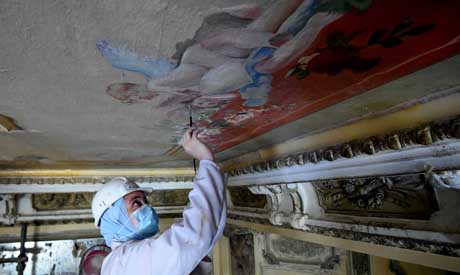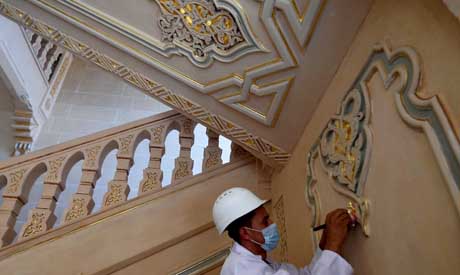Egypt: Recreating Sultan Hussein Kamel's palace
The Sultan Hussein Kamel Palace in Heliopolis, usually known as the Sultana Malak Palace, is being restored to be used as a centre for technological creativity

When Belgian industrialist Baron Empain started the construction of the Heliopolis suburb 10km northwest of Cairo from 1905 onwards, he had the support of Boghos Nubar, the son of Egyptian prime minister Nubar Pasha.
Once finished, it was a luxurious and leisured suburb with elegant villas with wide terraces, apartment buildings and tenement blocks with balconies, hotels and facilities, as well as recreational amenities including a golf course, a racetrack, and a large park.
Heliopolis also offered a variety of leasing and purchasing options, making it a practical choice for Cairo's well-heeled society at the time. This upscale character has remained the area's hallmark, and for over a century it has been a prime location in Cairo.

Empain also built his own magnificent palace in the Heliopolis Avenue of Palaces, now Orouba Street, in an Indian architectural style inspired by the temples of Angkor Wat in Cambodia and the Hindu temples of Orissa in India. Its external design incorporated reproductions of a variety of human figures, statues of Indian dancers, elephants, snakes, Buddhas, Shivas, and Krishnas.
Egypt's Sultan Hussein Kamel had his own palace in Heliopolis too. It was among the first buildings in the district and was designed by French architect Alexandre Marcel in 1908. It stood opposite Empain's Palace, which was re-opened in June 2020 after almost two years of restoration and became an exhibition venue for the history of Heliopolis.
Hussein Kamel resided in his Heliopolis Palace before becoming Sultan in 1914, and after he passed away it was then given to his wife, Sultana Malak, and was commonly known after her. After the 1952 Revolution, the palace was taken over by the government, and in 2000 it was put on Egypt's Antiquities List for Islamic Antiquities.

The palace is designed in the neo-Islamic architectural style that became popular at the end of the 19th and beginning of the 20th centuries and is characterised by traditional Islamic architecture with a European touch. It followed the European movement of the time, which had been one of architectural eclecticism, featuring historic styles such as neo-Baroque, neo-Renaissance, neo-Romanesque, and neo-Gothic.
The exterior design is decorated with traditional Islamic ornaments, including muqarnas columns, pointed arches, and foliage balconies on the façade. The core of the building is crowned with a dome decorated with floral ornaments and geometric decorative motifs along with Quranic verses from the surat al-fath and the hadith Qudsi of the Prophet Mohamed.
Although the general style of the Palace follows the neo-Islamic style, its interior design is neo-classical, as shown in the dining room and reception areas. The decorative elements and artwork inside the palace depict classical figures such as ancient Greek goddesses, the Medusa, and Cupid.
Today, the building is hidden under scaffolding as part of restoration and development work that will see it converted into a digital creativity centre dedicated to fostering young people's creativity and entrepreneurship. The new centre will include laboratories for international companies, advanced technological laboratories, technology incubators for emerging companies, training and meeting rooms, and co-working spaces.

Minister of Communications and Information Technology Amr Talaat said that 85 per cent of the restoration work has been completed, and now the teams are working on the final restoration, the mechanical and landscaping works, and the furnishing of the palace, providing it with the latest communication technology.
He said that Egypt's digital creativity centres, of which the restored palace will be a part, aim to contribute to the development of the ICT industry in Egypt through training the younger generation in different fields, spreading a culture of technological creativity by motivating young people to become entrepreneurs, and supporting the transformation of creative ideas into fully-fledged projects.
The centres are being developed within the framework of government interest in transforming historical buildings into centres for the development of creativity and entrepreneurship among young people, as well as in the light of the Ministry of Communications and Information Technology's plans to spread digital innovation centres throughout the country, providing an environment that stimulates technological innovation and entrepreneurship.
*A version of this article appears in print in the 5 August, 2021 edition of Al-Ahram Weekly
-- Sent from my Linux system.
No comments:
Post a Comment